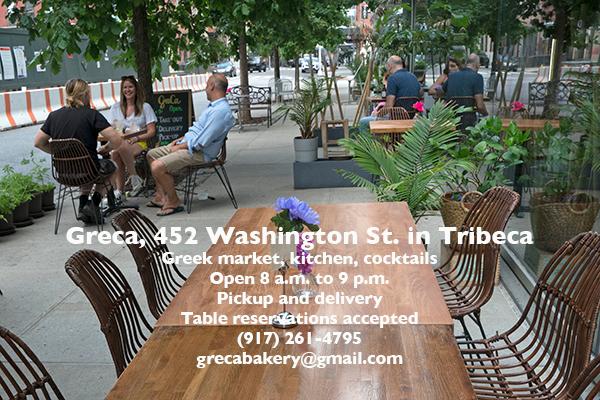|
DOWNTOWN
POST NYC
News and Events
in Lower Manhattan
|
|
|
|
Volume 6,
No.
27, July 5, 2020
|
QUOTE OF THE DAY:
"No one is taking victory laps because our work is far from over. We need to continue to re-think public safety in schools and our entire approach to policing."
- City Councilmember Margaret Chin, reflecting on the budget for FY '21 that was just passed by City Council
WEATHER INFORMATION: For current weather information,
click here.
COVID-19 CASES IN NEW YORK CITY: As of July 3 at 2:56 p.m.
1,858,501 tested * 213,212 confirmed cases * 23,140 deaths
Go to
www.DowntownPostNYC.com for breaking news and for updated information on facility closures related to COVID-19
MASTHEAD PHOTO: The USAF Air Demonstration Squadron ("Thunderbirds") flying over Lower Manhattan on July 4, 2020
(Photo: © Terese Loeb Kreuzer 2020)
|
Confederate monuments scattered throughout the South and the statue of U.S. President Theodore Roosevelt who sits astride a horse in front of New York City's Museum of Natural History, are in the news now. Teddy Roosevelt all by himself would be one thing, but he has been depicted with a Native American in full regalia on one flank and an African man wearing very little on the other. Many people are upset by these statues and think they should be moved, hidden away somewhere, or possibly destroyed.
We, in Lower Manhattan, know something about statue destruction. Our downtown predecessors went at it with gusto a few centuries ago, and didn't even ask permission. It happened like this:
Although the Declaration of Independence was signed in Philadelphia on July 4, 1776, it didn't reach New York City until July 9. By then, there were 10,000 British troops on Staten Island, with more on their way.
When Gen. George Washington received a copy of the Declaration of Independence, he ordered the colonial troops to assemble on the parade ground in what is now City Hall Park. There, the Declaration of Independence was read to them and to numerous citizens of the city. Fired up by the document's list of grievances and by its heroic language, a crowd rushed down to Bowling Green park at the foot of Broadway. In the center of the park was a large, gilded statue of King George III on horseback.
Forty soldiers and sailors lashed ropes to the statue and pulled it down. There have been numerous depictions of this scene. The 4,000-pound statue was dismembered and the head, which was said to be a good likeness of the king, was severed from the torso of the statue and disfigured. The New Yorkers declared that the statue would be melted down to make bullets.
Only a few fragments of the statue survived, among them the horse's tail. It's in the collection of the New York Historical Society.
The 18th-century fence surrounding Bowling Green park also survived, minus the orbs and crowns that the mob tore from the fence posts. The fence is a treasure now.
I wonder if the statue of King George III would also be considered a treasure if it hadn't been smashed? Centuries later, we discuss him with dispassionate, historical interest. If we could look at him lording it over us from atop his eight-foot tall pedestal, we might better understand the colonial rage.
Statue destruction is a tricky business. To people who have been hurt by what the statue represents, the statue is a painful reminder. By destroying the statue, they hope to diminish the pain. But burying history doesn't expunge it. The effects endure for future generations to try to understand, perhaps with bewilderment because some of the relevant information has been suppressed.
There's that to consider, and also something else. When statue destruction gets the green light, where does it stop? President Theodore Roosevelt, for instance, was a passionate conservationist who created our national park system and saved millions of acres of land from development, to be used recreationally by the public. He was also, in some ways, as were others of his time, a racist.
George Washington? Thomas Jefferson? They were slave owners. Should all monuments to them be torn down?
And here's another sticky question. In front of the Alexander Hamilton U.S. Custom House, now the National Museum of the American Indian across from Bowling Green park, are four statues of the continents by the renowned sculptor Daniel Chester French. He was one of the most acclaimed sculptors of the late 19th and early 20th centuries. Among his works, the statue of Abraham Lincoln in the Lincoln Memorial in Washington, D.C. is probably the most widely known.
Daniel Chester French's four continents are represented by four women, each surrounded by animals, people and objects that relate to what the sculptor considered to be their essential character. The figure of America is seen dominating the natives who were here when the Europeans arrived. Africa, the "dark continent," is depicted by a half-nude woman who seems to be asleep.
These are great works of art. Should they be destroyed because they're not politically correct by today's standards?
You will undoubtedly reach your own conclusions. I'm just asking.
Terese Loeb Kreuzer
Editor
|
|
The entrance to the National Museum of the American Indian on Bowling Green in Lower Manhattan. It was built to serve as the U.S. Custom House. The entrance is flanked by four statues by Daniel Chester French depicting the continents of Asia, Europe, America and Africa. (Photo: Terese Loeb Kreuzer)
|
Downtown Post NYC's website (www.DowntownPostNYC.com) is updated daily. That's the place to check for urgent messages, breaking news and reminders of interesting events in and around Lower Manhattan. So be sure to look at the website every day, especially if you want to know about breaking news.
Downtown Post NYC on Facebook: On its Facebook page, Downtown Post NYC has been providing information about the time of Governor Andrew Cuomo's daily press briefings and how to access them. DPNYC has also been highlighting some of Gov. Cuomo's announcements concerning COVID-19 statistics, reopening of various parts of the state for business and executive orders. Go to Downtown Post NYC's Facebook page by
clicking here.
HOW TO SUPPORT DOWNTOWN POST NYC: I made Downtown Post NYC free to subscribers so that no one who was interested in reading it would be excluded because of cost. Downtown Post NYC is largely supported by advertising revenue. In addition, some people have made contributions, which are much appreciated. For more information about how to contribute or advertise, email
[email protected].
|
HOW TO FORWARD DOWNTOWN POST NYC
If you would like to forward this email click the button below. Please do not forward this email in any other way, or your name may be automatically dropped from the subscription list. (That's how this email service works.) Thank you!
|

|
 CITY COUNCIL PASSES A 'PANDEMIC' BUDGET THAT NO ONE LOVES CITY COUNCIL PASSES A 'PANDEMIC' BUDGET THAT NO ONE LOVES
|
|
The room in City Hall where the City Council meets. (Photo: © Terese Loeb Kreuzer)
|
After a lot of dealmaking and some late nights, New York City Council passed the Fiscal Year '21 budget this past week. Both Margaret Chin, the City Councilmember for District 1, which takes in much of Lower Manhattan, and Manhattan Borough President Gale Brewer weighed in on it.
"This is a pandemic budget, and by no means a perfect budget," said Chin. "No one is taking victory laps because our work is far from over. We need to continue to re-think public safety in schools and our entire approach to policing."
Chin said that the terms of the City Charter require that City Council pass the budget by July 1 or else the budget falls to the New York State Financial Control Board. "I couldn't in good conscience vote in a way that would leave everything to chance and allow this budget to be determined by actors at the State level who don't have the best interests of the city at heart," said Chin.
Perhaps other members of City Council felt the same way and compromised as necessary so that the budget would pass.
Brewer commented that she knows "how brutal budget negotiations can be, having served on the Council's budget negotiating team for 12 years."
Chin, who is chair of City Council's Committee on Aging, said that she had successfully fought to restore $6.5 million for NORCs (Naturally Occurring Retirement Communities) in the city and for on-site nurses. She also persuaded her colleagues to allocate $8.4 million for senior centers, $4 million for Holocaust survivors and $1 million for case management programs.
Brewer was less enthusiastic about the amount of money devoted to the city's senior population. "While cuts to [the Department for the Aging] are minimal compared with other agencies, DFTA represents less than 1 percent of the city's budget," she said. "Cutting the Borough President's DFTA discretionary money will mean a $241,675 reduction in services in programs like Visiting Neighbors, Inc. and Harlem Wellness Center in Manhattan, and thousands more in the other four boroughs."
Both Brewer and Chin were pleased that some money was allocated to pay for summer jobs for young people. Mayor Bill de Blasio had proposed deleting that program. City Council put $115.8 million back in the kitty. In expressing her approval for this expenditure, Brewer referenced an Op-Ed from The New York Times by two economists, Dr. Sara Heller and Dr. Judd B. Kessler, who have studied the impact of summer jobs programs for young people in New York City and elsewhere. ("Mayor de Blasio, Bring Back Summer Jobs," New York Times, 6/29/2020).
They said that last summer, New York City's Summer Youth Employment Program - the largest in the country - provided jobs to around 75,000 young people between the ages of 14 and 24, nearly half of whom were black and one quarter of whom were Hispanic. Usually, the jobs are in non-profit day camps and day care centers, government agencies and for-profit businesses. Over six to seven weeks of employment, a summer worker can earn more than $2,000.
Brewer also expressed pleasure that City Council restored funding for some key City University of New York (CUNY) programs such as the one that enables low-income students to attend and graduate from community colleges.
But Brewer said that the $4.8 million allocated in the budget for school social workers was inadequate. "We need these critical workers now more than ever," Brewer said, "as the health crisis and resulting economic crisis merge in young minds into one giant mass of uncertainty."
- Terese Loeb Kreuzer
|

|
Bits & Bytes
 COLONIAL NYC FARMHOUSE FOR SALE; STUYVESANT HIGH SCHOOL PRINCIPAL DEPARTS; FINAL PRIMARY ELECTION VOTE STILL OUT COLONIAL NYC FARMHOUSE FOR SALE; STUYVESANT HIGH SCHOOL PRINCIPAL DEPARTS; FINAL PRIMARY ELECTION VOTE STILL OUT
|
|
A truck from the US Postal Service making a mail delivery in Tribeca. In this year's primary election, which took place on June 23, 2020, around 700,000 people voted by absentee ballot compared with 23,775 absentee and military ballots cast in the 2016 presidential election. (Photo: © Terese Loeb Kreuzer 2017)
|
"Principal of NYC's elite Stuyvesant High School leaving for another job," New York Post, 7/1/2020. "The principal of Stuyvesant High School, the crown jewel of New York's public education system and one of the top high schools in the nation, will depart for a new job at the end of the month," says the New York Post. The announcement came from the Department of Education that Eric Contreras will step down from his post atop the elite Lower Manhattan high school effective July 31 and will become principal at North Shore HS on Long Island. Contreras has held the position since 2016 and been with the DOE since 1996. In a letter sent Wednesday to school staffers, Contreras portrayed the decision to move on as a personal one as much as a professional one. For the complete article, click here.
"This 250-year-old NYC farmhouse is for sale - and shockingly pristine," New York Post, 7/3/2020. A house in Brooklyn that was standing when the Declaration of Independence was signed is currently for sale. "Brooklyn's Wyckoff-Bennett Homestead, which dates back to around 1766, has quietly hit the market for $3.2 million," says the New York Post. "Only three families have lived in the rare property over its 250-year history. There are about a dozen such houses in the borough. The Dutch Colonial farmhouse, located at 1669 E. 22nd St. in the Homecrest section of Sheepshead Bay, has four bedrooms and four bathrooms over 4,000 square feet. Period details added over the years include fireplaces with large mantels, wide-planked hardwood floors, wainscoting and built-in cabinets. The country kitchen has a vaulted ceiling, while an upstairs bathroom has a clawfoot tub. A descendant of one of the city's first Dutch settlers, Hendrick Wyckoff, built the house on 100 acres of farmland in the mid-1700s, and sold it to Cornelius Bennett in 1835. (Bennett's ancestor landed in Brooklyn in 1636, which would have made him one of the first residents in the area that later became Brooklyn.) It had no running water or electricity until the 1930s. The property stayed in the Bennett family until 1983, when Stuart and Annette Mont bought it for $160,000." For the complete article with photographs, click here.
"Demo Permits Filed For 321 Church Street In Tribeca," New York YIMBY, 7/3/2020. "Full demolition permits have been filed for 321 Church Street, aka 31 Lispenard Street, in Tribeca," says New York YIMBY. "According to the filing, the site is owned by Peter Matera of Urban Standard Capital. It currently houses a one-story mixed-use building with five units, two of which are residential. The 17-foot-tall structure was built in 1947. Plans for the 1,780-square-foot lot call for a seven-story, 10,036-square-foot mixed-use building with 9,191 square feet designated for residential space and 845 square feet for commercial use." For the complete article, click here.
"The long wait for New York City election results," City & State New York, 6/30/2020. The New York City Board of Elections was flooded with requests for absentee ballots this year, says City & State New York. In 2020, more than 700,000 absentee ballots were received, compared with only 23,775 absentee and military ballots filed during the 2016 presidential primary.
"The New York City Board of Elections is legally required to start counting absentee ballots by July 1," says City & State New York, "but that won't happen because of the immense number of absentee ballots. The vote counting will begin on Staten Island on July 6, with the remaining boroughs beginning their counts on July 8. This slowdown is happening in part because ballots need to be processed before they can be counted, which involves checking information like whether ballots have been signed and dated, and if a voter who mailed an absentee ballot also voted in person." It could take two to three weeks for the results to be finalized. For the complete article, click here.
|
|
|
ASSISTANCE WITH
Disaster Loans & Grants
Unemployment Assistance - available for W2 and Schedule C clients
Mandated additional sick pay and associated tax credit
Paycheck Protection Program; Extended tax loss carry-backs
|
|
Downtown bulletin board
 NEW YORK CITY ENTERS PHASE 3 OF STATE'S REOPENING PLAN
|
|
The Staten Island ferry will go back to its pre-Covid-19 schedule beginning on Monday, July 6, with rush-hour rides every 15 minutes. (Photo: ©Terese Loeb Kreuzer) |
New York City to enter 'Phase 3' of reopening: Except for indoor dining in New York City, which is not yet deemed safe, on
July 6 the city will enter Phase 3 of New York State's four-stage reopening plan. This will mean that tattoo parlors, nail salons and spas will be able to reopen. Low-risk youth sports can begin, with up to two spectators allowed per child.
Businesses and consumers must adhere strictly to the New York State guidelines and rules or there will be fines and other consequences. Violations of reopening rules can cause bars and restaurants to lose their liquor licenses. Individuals can be fined for open container and social distancing violations.
Alternate Side Parking and Staten Island ferry timetable: Alternate Side of the Street parking will be suspended
through July 12, and the Staten Island Ferry will go back to pre-COVID rush hour service as of July 6, offering rides every 15 minutes between 7 a.m. and 9 a.m. and between 5 p.m. and 7 p.m. Additionally, 20-minute service will be offered between 6 a.m. and 7 a.m. and between 3:50 p.m. and 4:50 p.m.
High Line reopening: The High Line will reopen to the public with limited capacity on
July 16 after temporarily closing in March to help limit the spread of COVID-19. The High Line, working with NYC Parks, also issued visitation protocols to ensure that visitors can maintain social distancing in full accordance with city guidelines.
New York City beaches reopened on July 1: On
July 1, eight public beaches in New York City reopened from 10 a.m. to 6 p.m. daily, when lifeguards are on duty. Swimming is prohibited at all other times. The beaches are Orchard Beach in the Bronx; Coney Island Beach in Brooklyn, Manhattan Beach in Brooklyn, Rockaway Beach in Queens, Midland Beach in Staten Island, South Beach in Staten Island, Cedar Grove Beach in Staten Island, and Wolfe's Pond Park Beach in Staten Island.
Social-distance guidelines must be maintained. NYC Parks ambassadors circulate with masks and watch to make sure that there are six feet of distancing between visitors. Public bathrooms at the beaches are open but bring your own sanitizer to use before and after. Although some food stands are open, it might be advisable to bring your own food. And be sure to bring plenty of water!
How to report police abuse: If you witness police abuse in person or see footage on social media, you can file a complaint with the City's Civilian Complaint Review Board at
nyc.gov/ccrbcomplaint or (800) 341-CCRB.
New York State Attorney General James, who is conducting an investigation of the George Floyd protests, asks that any information, including visuals, be shared with her office as they proceed with that investigation. Email:
[email protected]v.
United States Census 2020 is hiring: The 2020 U.S. Census will require a massive effort to document everyone in the country. The U.S. government is hiring census workers with a promise of "great pay, flexible hours, weekly pay and paid training." The jobs include census taker, recruiting assistant, office clerk, and supervisory staff. Applications can be made online at
2020census.gov/jobs. For more information, call 855-JOB-2020.
Register to vote: If you are not yet registered to vote, you can get registered so that you can vote in the general election, which will take place on Tuesday, Nov. 3.
Because of the Covid-19 pandemic, absentee ballots were made available for people to vote in the June 23 primary election. It is not yet known whether absentee ballots will be widely available for the Nov. 3 election. If they are available, it will be necessary to reapply, even if you did receive an absentee ballot to vote in the primary.
For answers to frequently asked questions about voting, click here.
For the partial results of the June 23 primary election, click here. (Absentee ballots are still being counted.)
Most of the Downtown Post NYC bulletin board listings are now on the Downtown Post NYC website. To see the bulletin board listings,
click here.
|

|
Downtown food news
 PEAK SEASON FOR GREENMARKET PRODUCE; NYC HEALTH DEPARTMENT'S GUIDELINES FOR DINING OUT SAFELY DURING C-19
|
|
Tomatoes for sale at a Manhattan Greenmarket. Tomatoes are among the fruits and vegetables now in season. (Photo: ©Terese Loeb Kreuzer) |
Tribeca Greenmarket now open on Wednesdays: As of July 1, GrowNYC's Tribeca Greenmarket on Greenwich Street between Chambers and Duane Streets is open on Wednesdays and Saturdays from 8 a.m. to 3 p.m. Farmers attending the Wednesday market include Jersey Farm Produce, with vegetables, herbs and small fruit from Hunterdon County, Meredith's Country Bakery with baked goods from Ulster County and Valley Shepherd Creamery with sheep cheese, yogurt and gelato from Morris County, New Jersey.
On Saturdays, the Tribeca Greenmarket vendors include Blue Moon Fish with wild-caught fish and shellfish from Suffolk County; DiPaola Turkey from Mercer County; Fledging Crow Vegetables with certified organic vegetables from Essex County; Francesca's Bakery with breads and baked goods from Middlesex County; Hudson Valley Duck Farm with heritage breed ducks and duck products from Sullivan County; Jersey Farm Produce with vegetables, herbs, and small fruit from Hunterdon County; Millport Dairy with cheddar cheese, beef, pickles and baked goods from Lancaster County; Miracle Springs Farm with fresh and aged goat cheese from Columbia County; Prospect Hill Orchards with apples & pears, some certified Organic, from Ulster County; Sun Fed Beef with grass fed and grain finished Angus beef from Madison County; Tucker Farm (formerly S + R Farms) with cut flowers from Burlington County; and Yellow Bell Farm with chicken and eggs from Columbia County.
GrowNYC asks that shoppers wear a face covering inside the market space and maintain a six-foot distance between themselves, Greenmarket staff, farm stand employees and other customers. Dogs and bicycles should be left at home.
Click here for a list of the fruits and vegetables now in season.
In addition to the Tribeca Greenmarkets, there are Lower Manhattan Greenmarkets at Bowling Green, City Hall, the Oculus and the Staten Island ferry.
Free grab-and-go meals at schools: After schools were shuttered at the beginning of the pandemic, the Department of Education launched a grab-and-go lunch program to ensure that New York City kids wouldn't go hungry. Soon after, the program expanded to include three free meals a day for all New Yorkers - not just students. And now the program will continue through the summer. No one will be turned away. Vegetarian and halal options are available at all sites. No registration or ID is required. No dining space is available, so meals must be eaten off premises. Parents and guardians may pick up meals for their children.
Meals can be picked up at all 435 meal hubs across the city from Monday through Friday, 7:30 a.m. to 1:30 p.m. Meal hubs will operate for children and families 7:30 a.m. to 11:30 a.m. and for adults from 11:30 a.m. to 1:30 p.m.
Find your pickup location by texting "FOOD" or "COMIDA" to 877-877 or by checking the website. The meal hubs in or near Lower Manhattan include Battery Park City School,
55 Battery Place; Stuyvesant High School, 345 Chambers Street; P.S. 001 Alfred E. Smith, 8 Henry Street; P.S. 126 Jacob August Riis, 80 Catherine Street; P.S. 130 Hernando De Soto, 143 Baxter Street.
Cocktails to go: Your favorite watering holes can still serve to-go alcoholic beverages through July 25. Click here for some places in Lower Manhattan that offer this service.
Dine Around Downtown, Cooking at Home edition: The Downtown Alliance has created a "Cooking at Home" edition of its popular food festival, Dine Around Downtown. Rocco DiSpirito, celebrity chef and cookbook author, is acting as host to three Lower Manhattan chefs as they demonstrate easy-to-replicate dishes from their restaurants. The series debuted on June 11 with Delmonico's executive chef, Billy Oliva, in the kitchen.
It continued
on June 25 when Michele Iuliano, co-owner and chef of Gnoccheria at 100 Broad St. showed participants how to make fresh hand-rolled gnocchi with three sauces: pesto, sorrentina and quatro formaggi. Finally, on July 9, Einat Admony, chef and co-owner of Taïm at 75 Maiden Lane, will call on her upbringing in Israel as she makes eggplant sabich salad and cauliflower shwarma. This event starts at 4 p.m.
The series is free to join via Zoom but registration is required and limited. If they wish, participants can donate to a fund of the restaurants' choice, which will support their staff and/or local food supply charities. Pre-register here: downtownny.com/dinearound
How to dine out safely during the C-19 emergency: The New York City Health Department has issued some recommendations and guidelines for dining out safely during the Covid-19 crisis. They include wearing a face covering at all times when not eating or drinking and staying at least six feet away from diners not in your party and, as much as possible, from restaurant staff. Restaurants are supposed to screen staff for Covid-19 symptoms before their shift and send them home, if sick. Staff members are supposed to wear a face covering at all times. Tables are supposed to be spaced with at least six feet between dining parties. For more Department of Health guidelines, click here.
|

|

|
|
|
|
|
|
HOW TO FORWARD DOWNTOWN POST NYC
If you would like to forward this email click the button below. Please do not forward this email in any other way, or your name may be automatically dropped from the subscription list. (That's how this email service works.) Thank you!
|
|
Downtown Post NYC is emailed to subscribers twice a week.
Editor: Terese Loeb Kreuzer
We welcome comments, questions and letters to the editor. Send them to
[email protected]
All articles and photographs in Downtown Post NYC are copyrighted and
may not be reprinted or republished without written permission.
© 2020
|
|
|
|
|